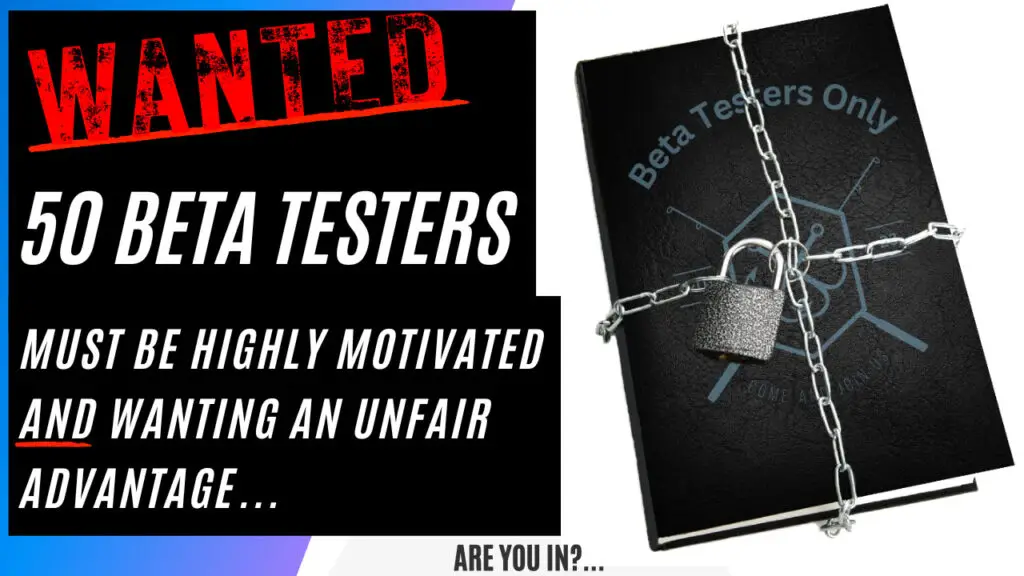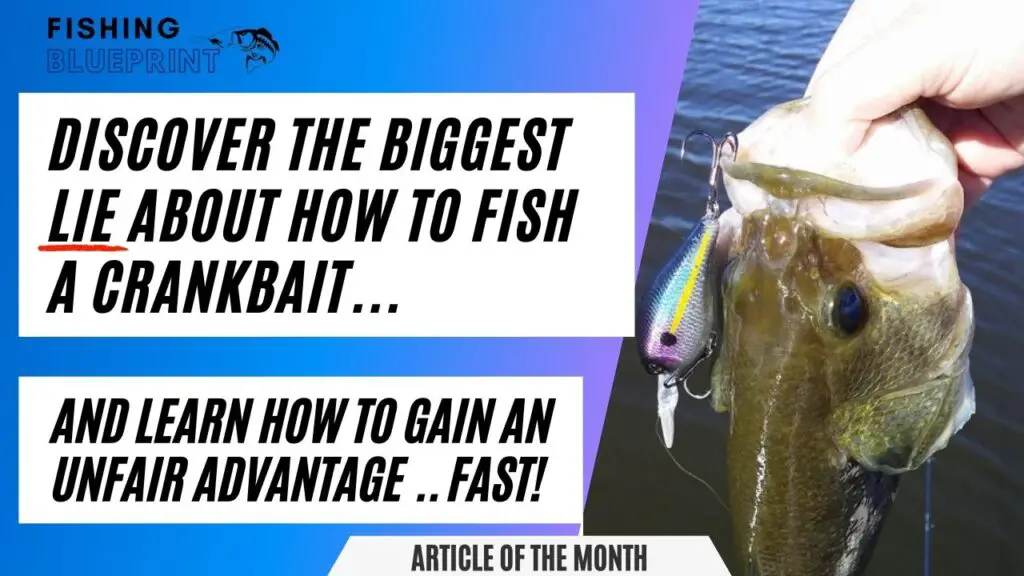How To Fish Lake Isabella | Your Lake Isabella Fishing Report
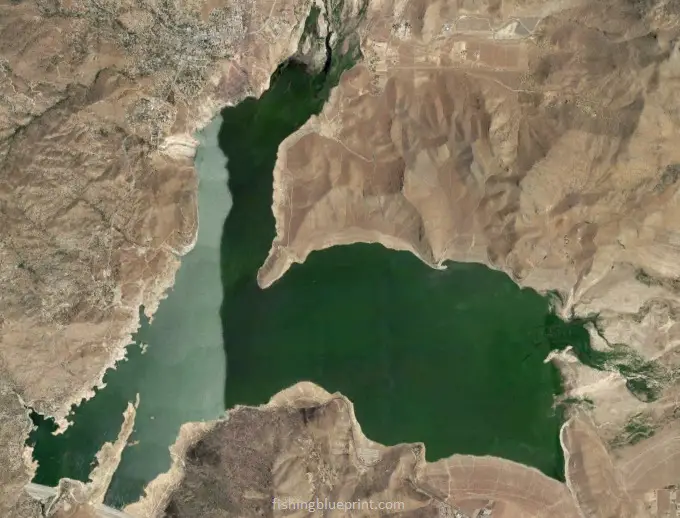
Lake Isabella is a moderately sized lake that sits 154 miles away from Los Angeles and 325 miles away from San Francisco.
Overall it’s a quiet lake and in this post you’re going to be given the blueprint to fish this lake.
So what are the best tips for fishing Lake Isabella? There are three important factors you must know if you want to know how to fish Lake Isabella successfully. First, you need to know what kind of fish is in Lake Isabella. Second, it’s important for you to know which part of the lake each species can be found. Lastly, knowing what are the best baits that work on Lake Isabella is vital. However, tactics, baits, and locations will be different for each type of fish that you target. So let’s talk about the steps you need to take in order to give you the best chance of catching a fish on Lake Isabella.
Key Takeaways
This lake gives locals and visitors the opportunity to test their luck in catching one of the many game species this lake has to offer, such as trout, bass, catfish, bluegill, and much, much more!
Here’s the most recent and updated Lake Isabella Fishing Report – it gives you a quick and easy list of some really good fishing spots. If you’re looking for more detail on how to fish each spot scroll down into the article.
- Lake Isabella Dam
- Engineer Point
- The Flume
- Rocky Point
- Boulder Gulch & French Gulch
- Old Cemetery to Wofford Heights Point
- Camp 9
- Paradise Point & Paradise Cove
Here are some additional fast and helpful tips just for you:
- The easiest way to fish this lake is by boat, but there are areas to fish from the bank, or by kayak or float tube.
- There are public boat ramps to use.
- Camping and RV parking is available.
- You can buy tackle and groceries at the lake or at one of the tackle shops in Bakersfield.
About Lake Isabella
Created by the Army Corps of Engineers in 1953, Lake Isabella is a moderately deep body of water with the average depth being 55 feet and a maximum depth of 185 feet when the lake is completely full. Lake Isabella is shaped like a “V” and each arm is approximately 5-6 miles long and spans over 11,000 acres total. This reservoir serves as a vital water collection project for drinking water, farming, and flood control.
Important Lake Warnings
Algae blooms may be present which may affect fishing, swimming, and water contact in general.
According to parks.ca.gov, “every one of California’s new laws requires boat operators to have a California Boating Card. The card is required for anyone under the age of 41 to operate a boat in California’s waters.”
If you are fishing and camping, fire bans may be in effect due to the ongoing drought conditions.
What Kind Of Fish Are In Lake Isabella
- Largemouth Bass
- Smallmouth Bass
- Spotted Bass
- Rainbow Trout
- White and Black Crappie
- Bluegill and Sunfish
- Catfish
Lake Isabella Fishing Tips & General Strategies
It can be a challenge to break down this body of water… So that’s why I created this Lake Isabella Fishing Report to help you to easily start catching fish fast!
Since this lake is vital for agriculture and drinking water collection the lake level often fluctuates.
The western side of the lake is known as the rocky side and is much deeper, and the eastern arm is more shallow and sandy with more vegetation and exposed brush.
Water Clarity:
Stained to slightly murky: A blessing in disguise for bass anglers, this level of water clarity creates the perfect environment for those fish to bite.
Structures and Fishing Cover:
Lake Isabella is a bass fisherman’s playground, loaded with structures and fishing cover that will have you reeling in those lunkers in no time. Here’s the skinny on what you can expect:
Rocky banks: Put on your game face and cast your line near these submerged gems. These banks serve as prime real estate for bass to hang out and ambush their prey.
Submerged trees: The bass hideout, submerged trees create an underwater jungle that bass love to call home. Toss your bait into the mess and watch as the bass come out to play.
Drop-offs: The ultimate bass highway, drop-offs provide bass with a place to cruise along and hunt for their next meal. Cast your line along these underwater ridges, and you’ll be hooking hawgs left and right.
Weed beds: The bass buffet, weed beds are a goldmine for attracting baitfish, which in turn attracts bass. Get your bait in the mix and you’ll have bass lining up for a taste.
Docks and boat ramps: Bass magnets, these man-made structures create the perfect hiding spots for bass to ambush prey. Flip your bait under the docks or cast near the boat ramps for a chance at catching a toad.
Coves and inlets: The bass nursery, these protected areas are breeding grounds for bass and their prey. Work your bait along the shoreline and be prepared for some bass thumb action.
With frequent trout planting efforts, this lake gives anglers a massive opportunity to catch healthy trout.
As with most trout, during the summertime trout prefer the coolest water the lake can provide that is just above the thermocline. And in Lake Isabella anglers commonly report the thermocline being approximately 30-45 feet deep.
The easiest way to catch these silvery fish is to troll with a downrigger.
However, Lake Isabella also has some great bass fishing. Bass are not as pressured as trout is in this lake and you can catch a good size largemouth in the backs of coves or in vegetation. Smallmouth bass prefer rocky terrain such as steep rocky banks, ledges, and drop offs.
Most of the fish such as bass, bluegill, crappie, and catfish will spawn in the spring. Bass will spawn in 1’-15’-feet of water notably on rocky structure, gravel flats, humps, and small creek inlets and cuts.
When the summer heat sets in, the bass, bluegill, and crappie will move to deeper water to approximately 15’-30’-feet of water. Focus on drops offs, channels, points, submerged humps. Deeper area with chunk rock ranging from baseball to basketball size will attract predatory fish like bass, crappie and catfish because it provides a safe area the prey (crayfish, bream, and minnows) can hide.
If you can find the ideal spot at the ideal depth then it will most likely assist you in catching fish.
Springtime Fishing update
Heads up, fellow anglers! We’ve got a summary of recent fishing reports from our buddies at Lake Isabella. Check out what’s been working for them this spring:
- Water Temperature: Ranges from 47-degrees in the early spring, and around 60-65-degrees °F in the late springtime.
- Water Clarity: Stained to muddy (0-4 foot visibility) – perfect for those bass to ambush prey.
- Wind and Weather: Expect windy and cold conditions at times, so bundle up and hold on tight to your rod.
Techniques that are working:
For Bass:
- Carolina rig: Slow and steady wins the race with green lizards on a Carolina rig. Our friend Mike had success with this technique, landing six nice bass in just four hours. For some reason Carolina rigged green lizards or baby brush hogs have been the go-to color.
- Jigs: slow crawling over secondary points. Football head jig on a pumpkin pepper hula grub
- Crankbaits or jerkbaits: worked over rocky structures
For Crappie:
- Small minnows with a bobber: can never go wrong with live bait.
- Bright colored jigs or tubes: Contrasting colors have been the way to go. Jon B reported catching limits after limits during the spawn.
For Trout:
- Small minnow lures and spoons: designed to look like small bait fish these can be fished at any depth.
- Flys: These can also look like minnows or even bugs. Go with a black, green, or brown wooly bugger or a white streamer
Where anglers are catching fish:
For Bass:
- Anglers have found success fishing rocky points, marinas, and shallow areas. Check out: French Gulch, The Flume, Rocky Point, Old Cemetery to Wofford Heights Point, Camp 9, Paradise Point & Paradise Cove
For Crappie:
- Look for crappie around rocky points and marinas. Use small minnows with a bobber or bright colored jigs 3-4 feet apart for best results.
- Check out: Lake Isabella Dam, French Gulch, Engineer Point, The Flume, Rocky Point, Old Cemetery to Wofford Heights Point, Camp 9, Paradise Point & Paradise Cove
For Trout:
- More likely to be shallow, in water 10-20 feet
- Check out: Lake Isabella Dam, French Gulch, Engineer Point, Rocky Point, Paradise Point & Paradise Cove
Lake Isabella – Summer Fishing update
Hey fellow anglers, here’s a breakdown of what’s been working during the summer months at Lake Isabella based on the reports from our fellow fishers:
- Water Temperature: Ranges from 66-82°F in the summer season. Keep an eye on the temps and adjust your approach accordingly.
- Water Clarity: Varies from clear to muddy (0-4+ foot visibility), so be ready to adapt your tactics to the conditions.
Techniques that are working:
For Bass:
- Dropshot: It’s been a successful technique for catching bass, with anglers reporting good numbers of fish.
- Crankbaits: Many fishers found success with crankbaits, both shallow and deep-diving ones, during various times of the day.
- Topwater: Zara Spooks and Lunker Plunkers have produced some explosive topwater strikes, especially during early mornings.
- Plastics: Soft plastics like Senkos, worms, and creature baits have been effective when fished around cover and structure.
Baits that are working:
For Bass:
- Crawdad cranks: This pattern has been productive, especially when targeting rocky points and structures.
- Soft plastic worms: Senkos, Zoom trick worms, Roboworm
- Soft plastic creature baits: Zoom brush hog, Strike King Rage Bug baits have all been effective for bass during the summer months.
For crappie:
- Vertical Jigging: using a tiny jig or small soft plastic bait slowly bounce the bait up and down over submerged structure, like brush piles or standing timber to entice a bite.
- Spider Rigging: Trolling with multiple rods and lures at different depths to locate crappie schools.
- Slip Bobber Rigging: Using a slip bobber allows you to present live bait or a jig at a precise depth where crappie are holding.
- Cast and Retrieve: Cast small jigs or soft plastics near structures like laydown, along weed lines, or over standing timber. The trick is to slowly retrieve the lure with a stop-and-go motion or a steady retrieve, depending on the crappie’s mood.
Where anglers are catching fish:
For Bass:
- Fish have been caught near rocky points, flats near deeper water, and around structures like trees or rock piles.
- Check out: French Gulch, Engineer Point, The Flume, Rocky Point, Old Cemetery to Wofford Heights Point, Camp 9
For Crappie:
- Similar to bass, look for laydowns, deep weed lines, or standing timber
- Check out: Lake Isabella Dam, French Gulch (mouth and in the main channel), Rocky Point, Old Cemetery to Wofford Heights Point, Camp 9
For Trout:
- Trout are more likely in deeper water in the summer.
- Check out: Lake Isabella Dam, French Gulch (mouth)
But Where Are The Best Places To Fish At Lake Isabella?
And in no particular order here is that list of the best fishing spots at Lake Isabella.
DISCLAIMER: The material provided is for general information purposes only. It’s important to understand that any information provided in this article can change at any time. Any maps or graphics featured are not to be used as navigational aids. Fishing Blueprint will not be responsible for any personal injury or property damage from any misuse of the maps or graphics provided. It’s completely impossible to give you every single spot where you can potentially catch a fish. But, what this list does do is to give you a helping hand and narrow down to the most productive fishing spots.
Lake Isabella Dam
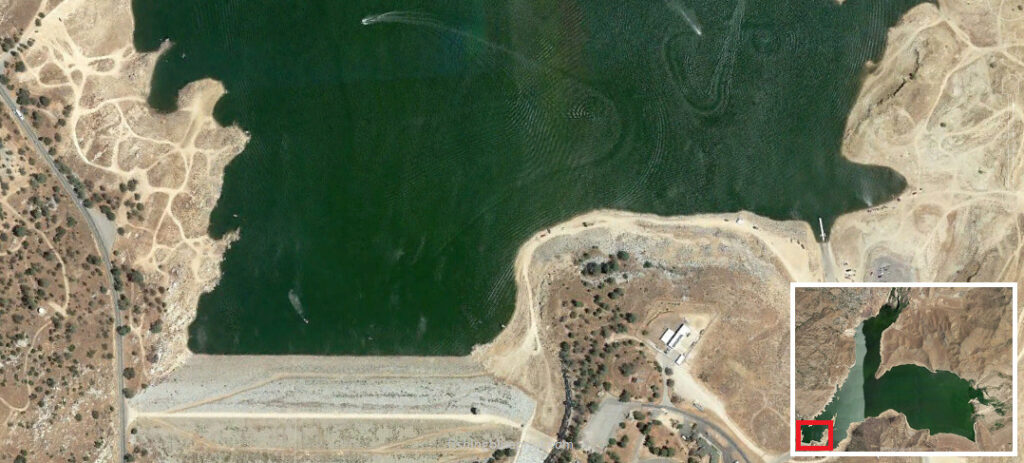
Fishing from Isabelle Dam up to Engineer Point can offer exceptional results when trolling for trout.
In case the water level is low, use a fish finder to locate deep water humps in the cove just west of the dam; these spots are rarely fished.
Be aware that this part of the lake is prone to strong winds. Even with an excellent trolling motor, the wind can quickly push you off your desired spot, significantly reducing your chances of landing a fish.
For this reason, we highly recommend investing in a top-quality drift sock. If you’re unfamiliar with the term, a drift sock is like an underwater parachute. When the breeze picks up, it’s essential to slow your drift so your lure remains in the strike zone long enough to attract a fish.
By the way, we found a really good quality drift sock made by Mythik Outdoors, and best of all they’re sold on Amazon.com. Go here to learn more about drift socks and read the reviews from actual customers.
Located: south lake
Structural features: steep rocky bank
Best species to target: trout,
Most effective way to fish this spot: boat, kayak
French Gulch

This section features a short cove that is characteristically very steep and its banks are lined with large chunk rock to boulder-size substrate.
Naturally, crawfish, bluegill, minnows, and shad seek shelter in this area.
It’s best to focus your efforts on cuts, points, boulder piles, and transition areas from larger rock to smaller rock size.
The mouth of the gulch is great for trout fishing.
In the back of the cove, largemouth and smallmouth bass as well as crappie will be caught here.
Located: south lake
Structural features: steep rocky banks
Best species to target: trout, bass, crappie
Most effective way to fish this spot: boat, kayak, shoreline
Engineer Point
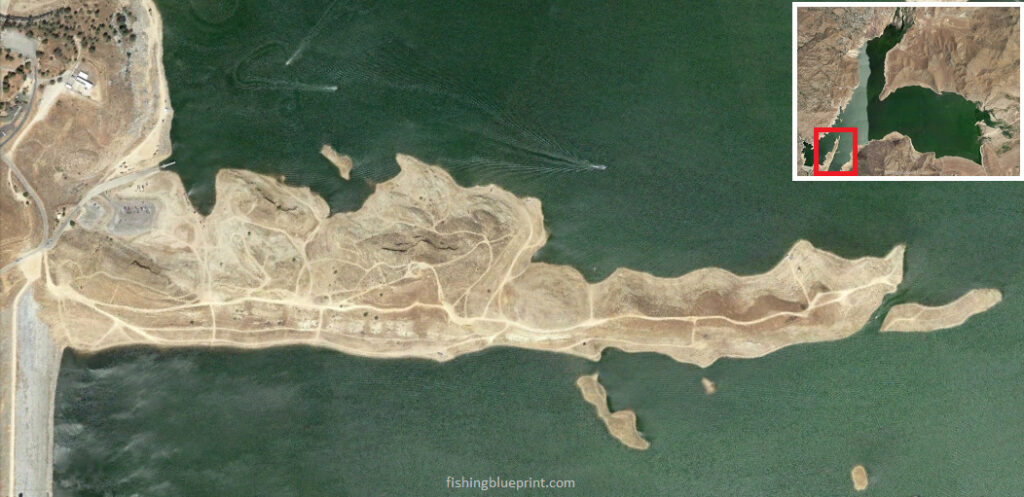
Engineer Point features a long main lake point. Its banks are characteristically very steep and made from large chunk rock to boulder-size substrate.
Trout, bass, crappie, pan fish, and catfish are all caught here.
Naturally, crawfish, bluegill, minnows, and shad seek shelter in the large rocks.
Given this embankment’s large area, it’s best to focus your efforts on cuts, points, boulder piles, and transition areas from larger rock to smaller rock size.
Located: middle section of the lake
Structural features: long rocky bank
Best species to target: trout, largemouth bass, smallmouth bass, crappie, catfish
Most effective way to fish this spot: boat, kayak, float tube, shoreline (or off the dock)
The Flume
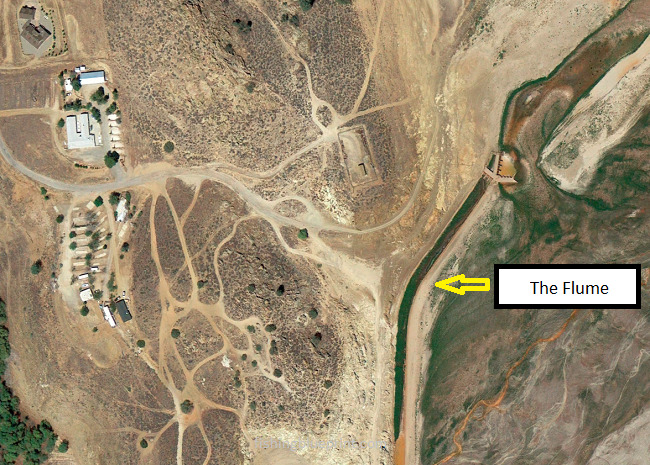
The “Flume”, also known as the Boreal Canal is a large man-made structure that served as an irrigation canal before the lake was created. The concrete canal is unique because it has large raised berms that elevate it above the ground, kinda like roadbeds.
It travels from north to south, starting at Wofford Heights and down all the way to the auxiliary dam.
This large structure should be fished as if you were fishing a submerged roadbed.
Start by scanning for bait fish at a specific depth. Starting shallow and working your way deeper.
Next, look for larger fish holding near or close to the flume. Bass will hold more horizontally, maybe 2-3 fish high, max. However crappie will school together more vertically.
If you’re not having any luck, quickly search for other structures the Flume transects like an old bridge, a drainage ditch, or a culvert.
Bass, crappie, bluegill, and catfish are often caught in the shallower sections of the Flume. Conversely, trout have been know to be caught in the deeper sections.
Located: Eastern shoreline (runs parallel), north to south.
Structural features: elevated man-made structure
Best species to target: bass, crappie
Most effective way to fish this spot: boat, kayak, float tube
Look carefully at this spot with low water level. This is the NORTH end of the Flume…
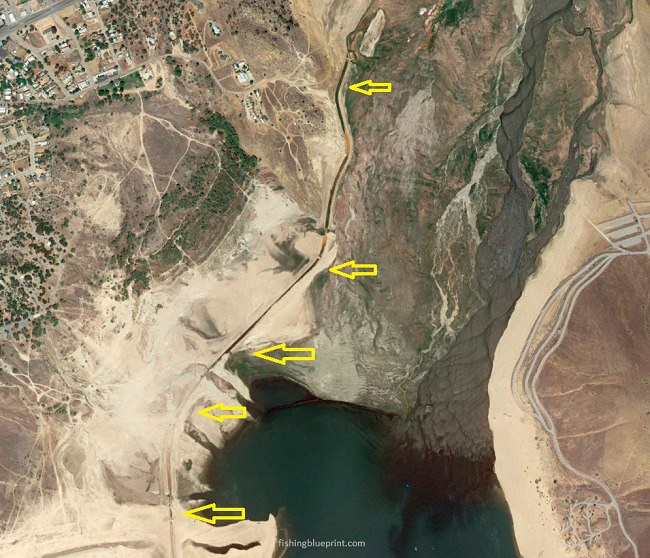
Now look at this spot submerged when the lake is at normal pool…
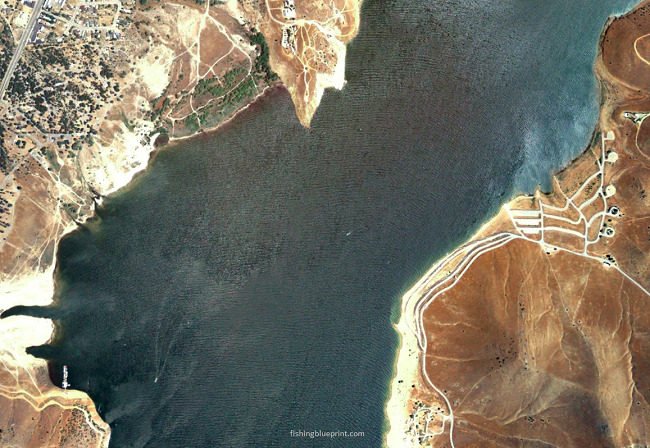
Look carefully at this spot with low water level. This is the SOUTH end of the Flume…
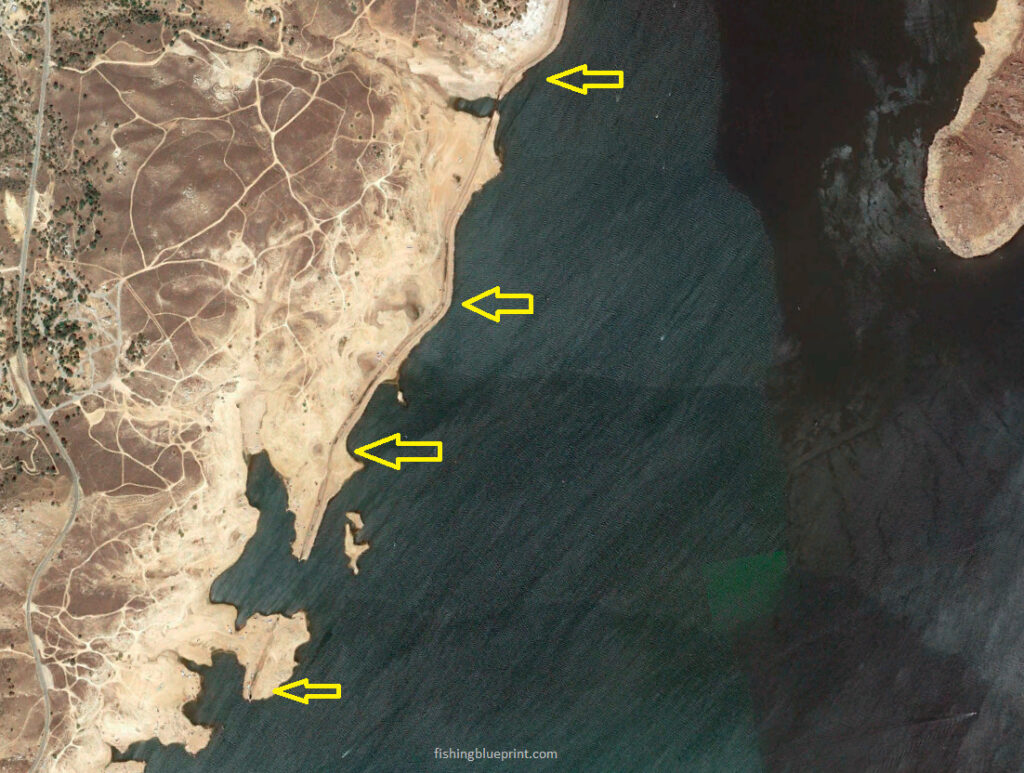
Now look at this spot submerged when the lake is at normal pool…
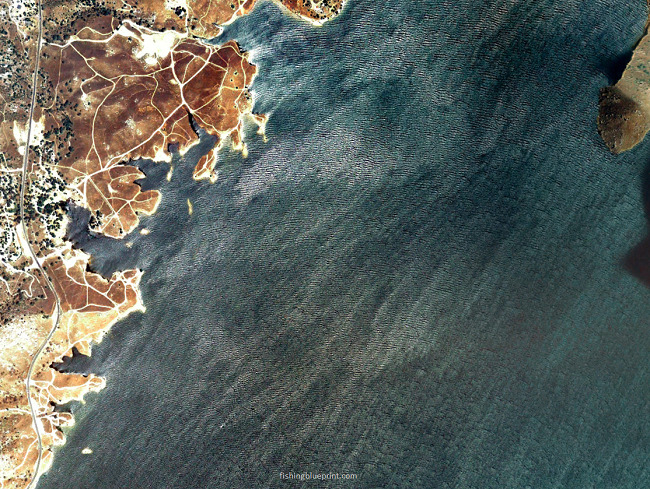
Rocky Point
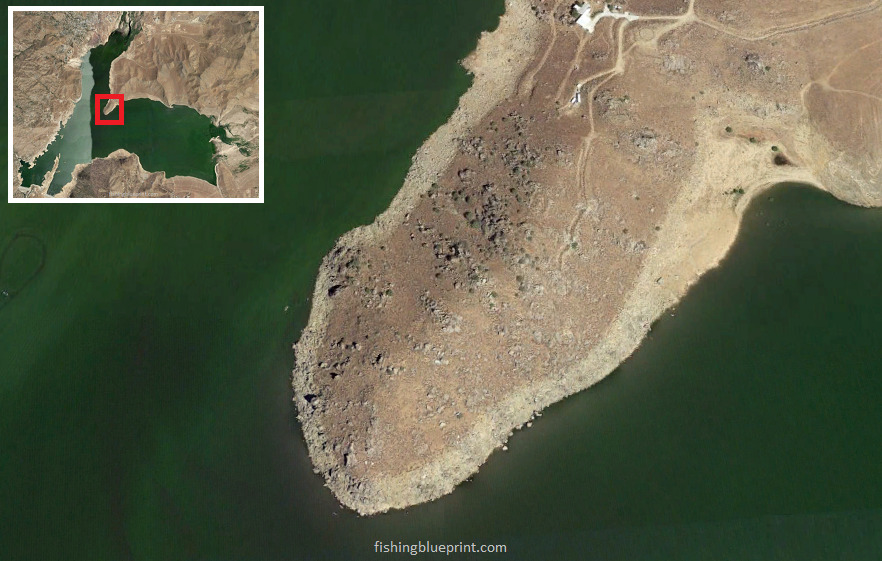
This part of the lake is home to one of the best long points with rocky riprap structure on its banks.
The tip of this point is covered in thick chunk rock, in which the size can range from small boulders to basketball sized rock (also known as “rip rap”).
The point is characteristically steep and crawfish, bluegill, minnows, and shad seek shelter in this area, which in turn attract bass and other predatory fish.
It’s best to focus your efforts on cuts, piles of rock that create a ‘point on the point’, fishing the largest of boulders in that area, as well as, the transition areas from larger rock to smaller rock size.
During the summer, top water baits work really well one hour before and after the sunrise/ or sunset. A great midday strategy is to come back to this spot and scan this area with a fish finder and locate the thermocline. Chances are the bass will hold just a few feet above the thermocline. Once identified, target these riprap points with a lure that can be used at that specific depth.
Located: mid lake
Structural features: long rocky point dropping into deep water
Best species to target: bass, crappie, trout
Most effective way to fish this spot: boat, kayak, float tube
Old Cemetery to Wofford Heights Point
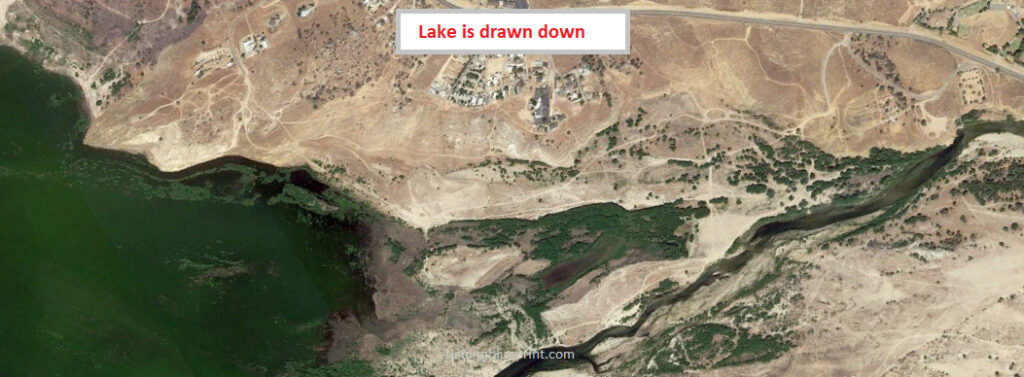
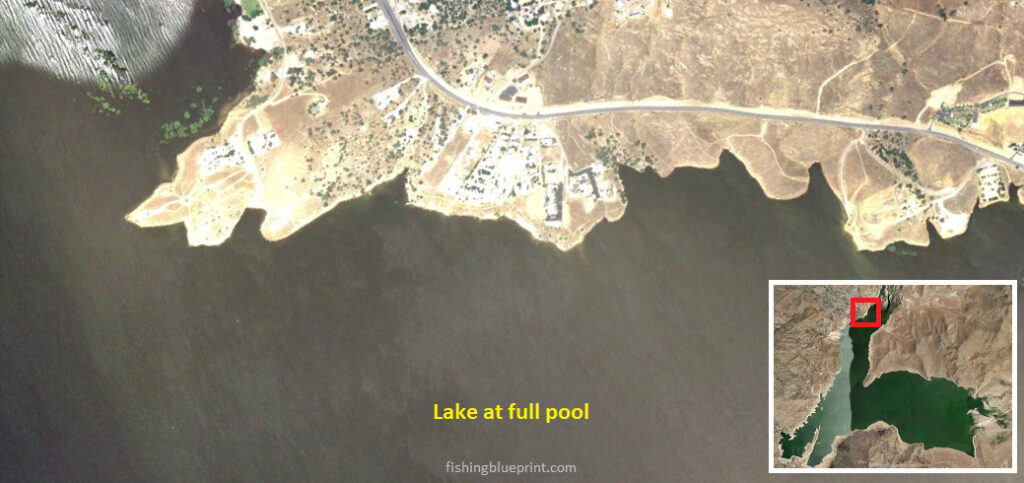
This fishing spot runs the western bank of the Kern River. Starting at the Old Cemetery all the way down to Wofford Heights Point.
The main river channel swings that run into the bank multiple times and thus creates several underwater humps, and ditches.
Additionally, these secondary ditches provide sanctuary to bass and crappie should they feel threatened.
Furthermore, this expansive area is covered in vegetation. Sometimes this vegetation can grow to the surface creating a floating mat or canopy when the water level is high.
On the other hand, when the lake is at low pool the receding water will expose standing timber and can make for great fishing if you enjoy flipping and pitching in order to catch bass.
Lastly, if the water is cold, trout can be found and caught in this stretch of the river.
It’s relatively shallow (between 3 and 10 feet deep) and what makes this spot unique is all the cover the fish can hide in and call home. Parts of the flat close to deep water, if the fish feel threatened, they can retreat to. Fishing the outside edges can frequently result in fish being caught.
There are several hard bottom patches, small rock piles, and high spots on humps that should be checked for fish.
Lastly, when the lake gets windy you can fish Kelsey Creek Inlet and still get bit.
Here is how I recommend to fish this area.
Located: north lake
Structural features: channel swing into bank dropping into deeper water, submerged and emergent vegetation.
Best species to target: bass, crappie, trout
Most effective way to fish this spot: boat, kayak, float tube, shore fishing
Camp 9
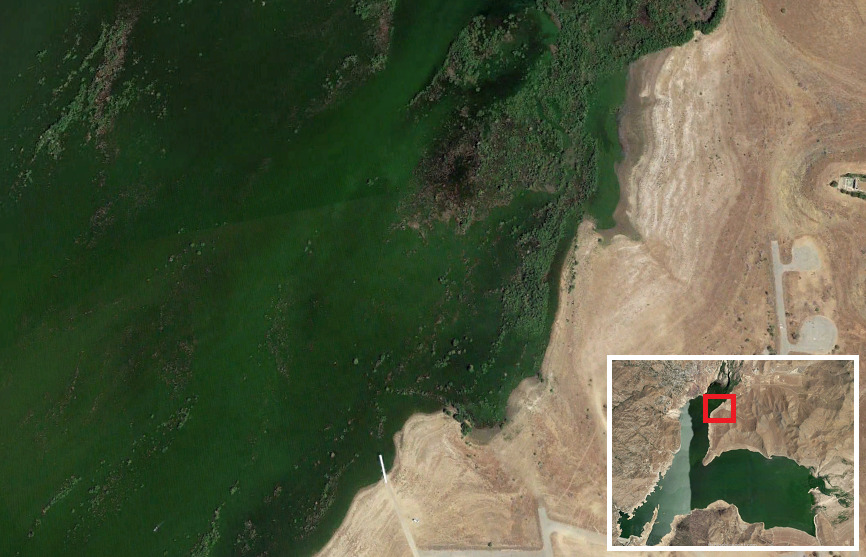
This location is fantastic due to its “vegetation flat” with essential structure. It’s a sizable area with minimal depth variation and abundant vegetation.
When water levels are high, this vegetation can grow to the surface, forming floating mats or canopies. Conversely, during low water levels, the receding water exposes standing timber, providing excellent fishing opportunities for those who enjoy flipping and pitching for bass.
This vast flat becomes highly productive when weeds are growing or dying off, creating deep channels within the vegetation. Bass can hide in these weed-filled holes and ambush prey.
The area is relatively shallow, ranging between 3 and 10 feet deep, and the abundance of cover offers numerous hiding spots for fish. Portions of the flat near deep water provide a retreat for fish if they feel threatened. Fishing along the outer edges often results in catches.
If the grass is submerged, use topwater lures, buzzbaits, frog lures, chatterbaits, or whopper ploppers to fish over the tops.
For floating vegetation mats, opt for frog lures, flipping lures, heavy vegetation punching baits, or Texas-rigged Senkos.
In the case of vertical emergent vegetation like tall tulles/cattails or thin twig-like reed patches, use frog lures, flipping lures, or heavy vegetation punching baits. If it’s breezy and you’re fishing emergent vertical vegetation, switch to spinnerbaits, swim jigs, or chatterbaits.
Parallel fish the weedline edges with crankbaits, lipless crankbaits, spinnerbaits, frog lures, soft plastic swimbaits, umbrella rigs, swim jigs, underspin jigs, or chatterbaits.
Look carefully you will see the primary channel and a secondary channel…

If you further study this area you’ll find many different spots to fish; natural points, pockets, and the thickest mats…
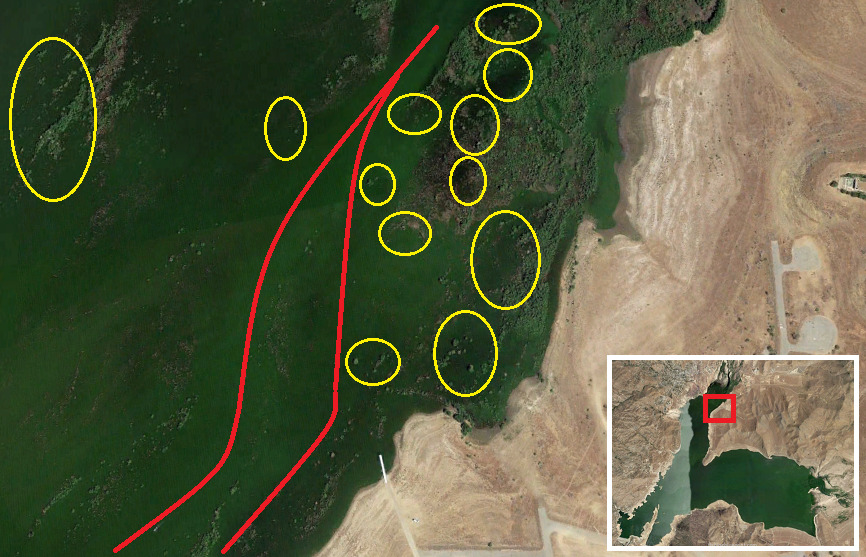
Located: north side side
Structural features: emergent and submerged brush and weedbeds
Best species to target: largemouth bass, crappie, sunfish
Most effective way to fish this spot: boat, kayak, float tube, shoreline.
Paradise Point & Paradise Cove
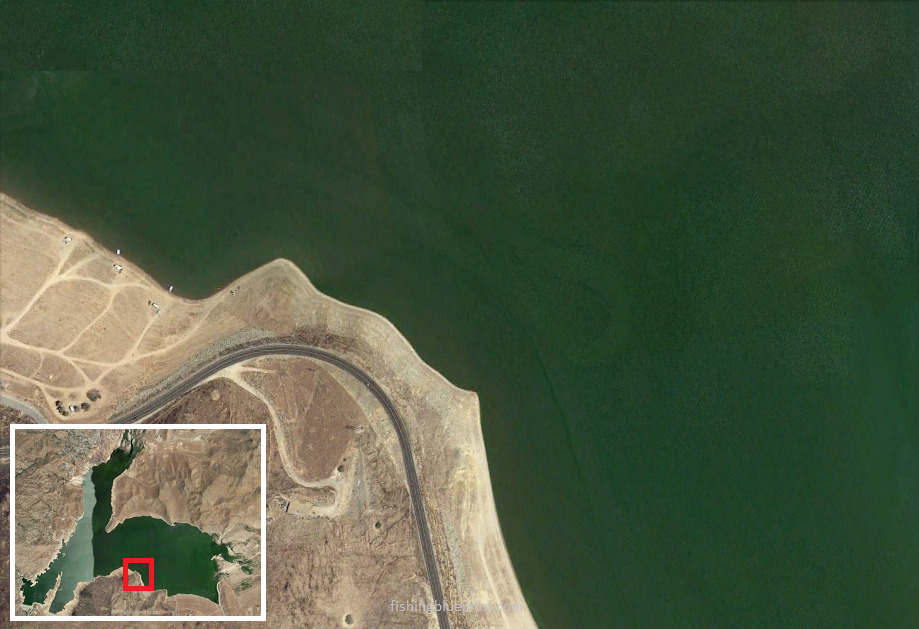
At first glance this location may not seem like a good spot to fish… but don’t let this fool you.
This spot is unique because the South Fork Kern River swings into the point, making it a good spot that can be fished year round.
It can hold fish along the steep bank itself, particularly around any large boulders or submerged shelves, or the fish will be located on transition zones where it goes from a steep to gradual sloping bank.
The transition areas will turn from steep rock wall ledges, to boulders, then to chunk rock and pea-gravel.
Lastly, artificial structures in the form of Christmas trees have been placed in Paradise Cove (east of Paradise Point).
Look carefully you will see the primary channel swing into the point…
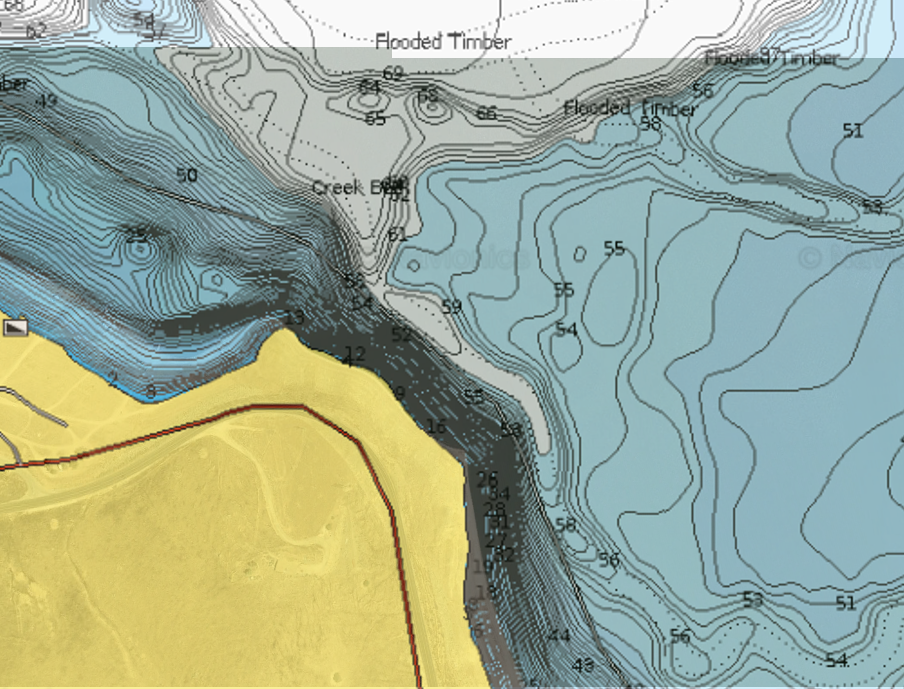
Located: south east lake
Structural features: river channel swinging into a steep bank
Best species to target: largemouth and smallmouth bass, crappie, sunfish, catfish
Most effective way to fish this spot: boat, kayak, float tube
Boat Ramps at Lake Isabella
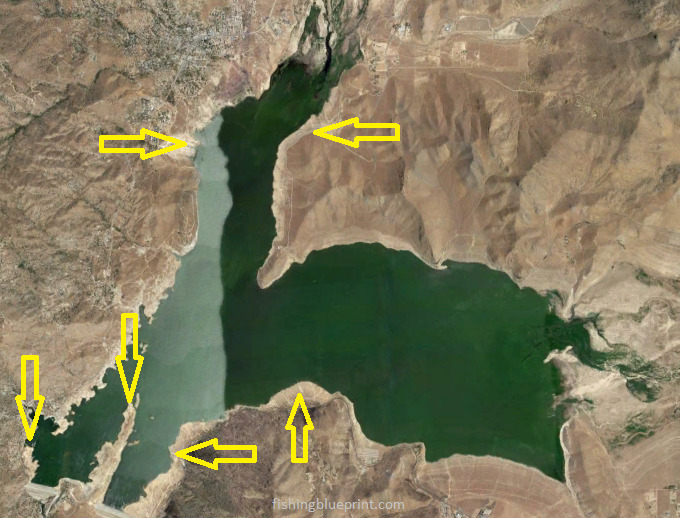
French Gulch Boat Launch Ramp
CA-155, Lake Isabella, CA 93240
Website: frenchgulchmarina.com
Phone number: (760) 379-8774
Lanes: 1
Restrooms: Yes
Showers: no
Gas: Yes, at the marina
Tackle, groceries, snacks available: Yes, at the marina
Fish Cleaning Station: Yes
Camping nearby: Yes
Site 19 Boat Launch Ramp
Address: Lake Isabella, CA 93240
Website: here
Phone number: (559) 784-1500
Lanes: 2
Restrooms: Yes
Showers: no
Gas: no
Tackle, groceries, snacks available: no
Fish Cleaning Station: no
Camping nearby: Yes
Old Isabella Boat Launch Ramp
Address: Lake Isabella, CA 93240
Website: here
Phone number: (559) 784-1500
Lanes: 1
Restrooms: Yes
Showers: no
Gas: no
Tackle, groceries, snacks available: no
Fish Cleaning Station: no
Camping nearby: Yes
South Fork Boat Launch Ramp
Address: Lake Isabella, CA 93240
Website: link
Phone number: (559) 784-1500
Lanes: 2
Restrooms: Yes
Showers: no
Gas: no
Tackle, groceries, snacks available: no
Fish Cleaning Station: no
Camping nearby: Yes
Tillie Creek Launch Ramp
Address: Wofford Heights, CA 93285
Website: none
Phone number: none
Lanes: 1, *may be closed due to low water levels.
Restrooms: Yes
Showers: no
Gas: no
Tackle, groceries, snacks available: no
Fish Cleaning Station: Yes
Camping nearby: Yes
Marinas at Lake Isabella
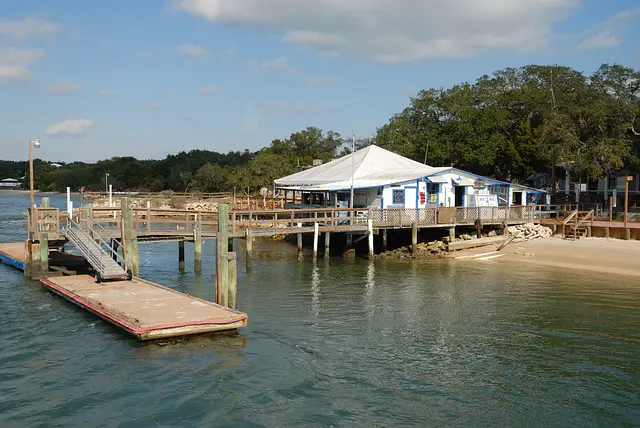
French Gulch Marina
Address: CA-155, Lake Isabella, CA 93240
Website: frenchgulchmarina.com
Phone number: (760) 379-8774
Nearby boat ramp: Yes, 1 lanes
Restrooms: Yes
Showers: no
Gas: Yes
Tackle, groceries, snacks available: Yes
Fish Cleaning Station: Yes
Camping nearby: Yes
Red’s Marina
Address: Lake Isabella, CA 93240
Website: none
Phone number: (760) 379-1634
Nearby boat ramp: Yes
Restrooms: Yes
Showers: no
Gas: Yes
Tackle, groceries, snacks available: Yes
Fish Cleaning Station: Yes
Camping nearby: Yes
Tackle Shops Near Lake Isabella
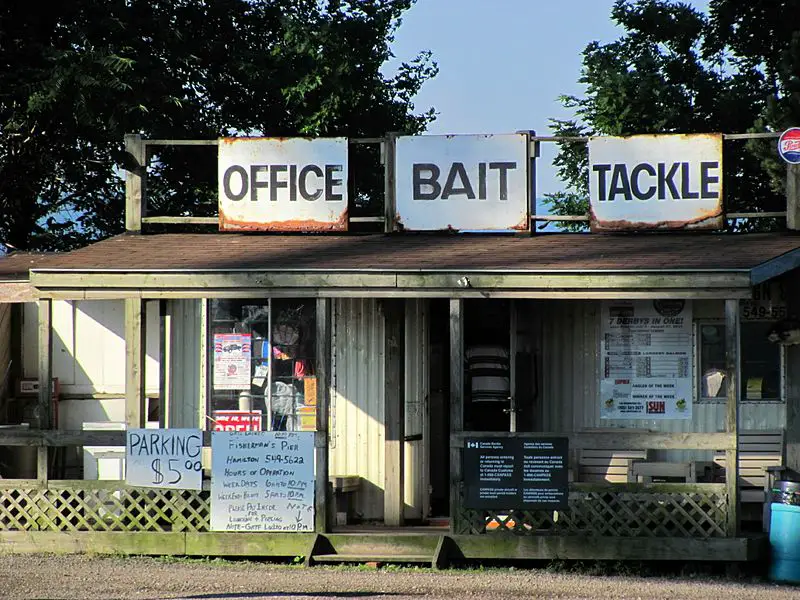
Cope’s Tackle & Rod Shop
1654 Calloway Dr, Bakersfield, CA 93312
tackleandrod.com
(661) 679-6351
Kern River Fly Fishing / Fly Shop
11301 Kernville Rd suite b, Kernville, CA 93238
kernriverflyfishing.com
(760) 376-2040
Riverside One Stop
10800 Kernville Rd, Kernville, CA 93238
riversideonestop.com
(760) 376-1688
Bob’s Bait Bucket
2131 S Chester Ave, Bakersfield, CA 93304
bobsbaitbucket.com
(661) 833-8657
Camping Near Lake Isabella
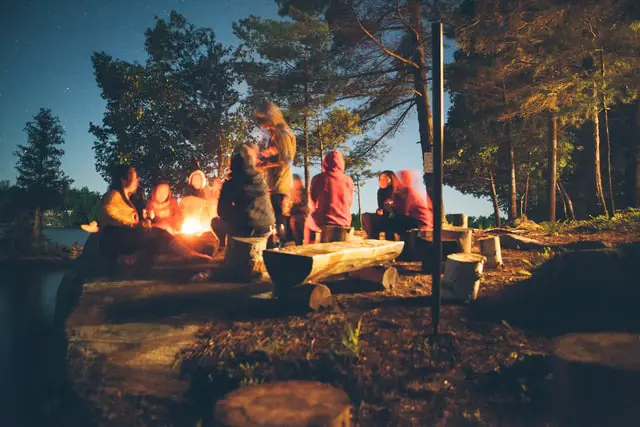
There are plenty of areas to camp. Here’s a list of some of the areas:
- Auxiliary Dam Campground
- Old Isabella Road Recreation Site Campground
- South Fork Rec Campground
- Paradise Cove Campground (Sequoia National Forest)
- Lake Isabella / Kern River KOA
- French Gulch
- Hungry Gulch Campground
- Boulder Gulch Campground
- Live Oak Campground
- Camp 9
- Tillie Creek Campground
- Haven RV Park
- Sandy Flat Campground
In Summary...
As you now can see Lake Isabella fishing can be tough at times, but it’s not impossible and with the help of the Lake Isabella Fishing Report… It definitely helps you get started on the right foot quickly and easily, so you can avoid wasting hours wondering where and how to get started.
Did You Get All This?
As fellow fisherman and content creator I thrive on helping others… I feel like I can do the most good by helping others… And frankly… I would feel like I did something wrong if you didn’t walk away feeling a little better about this lake.
I truly want to over deliver for you…
So Let Me Ask You Another Question…
After reading this helpful report:
- Can you see how this could change the way you would fish this lake?… To make it easier, faster… and… with less headache, less frustration?
- If nothing else, do you now have a better sense of where you can get started, even if you have have been here?
- Do you feel that you have a good grasp of what species to expect in this lake?
- Do you have a good understanding what baits are needed to catch each of the different species of fish?
- Earlier we came up with some helpful spots to catch more fish, can you see yourself considering any one of those spots? Which ones are you the most excited about implementing when you get to the lake?
- Is it fair to say that using these spots would give you a significant advantage over someone else who’s fishing this lake?
I Need To Ask A Favor From You And It’s Not Going To Cost You A Single Dime…
If you have gotten anything out of this free report; whether its knowing where to get started, what kinds of fish are in Lake Isabella, what baits to use, where to launch your boat, where to buy a frosty beverage, where to camp, and other things to do when you’re at this lake…
Then I need you to do something that is going to help your fellow angler…
And that is share this report. Please share it to as many people as you can. It’s free to you and it really helps me out as a creator.
Lastly… thank you for spending your time reading through this report and I hope you have a luck on the water.
THIS IS WHERE YOU CAN HELP ME THE MOST: There’s a lot of information about this subject you have found helpful, and I’m sure you’ll be able to put some of the knowledge bombs to use. But sharing this report helps drive traffic which in turn helps me at absolutely no cost to you. I love creating reports like this for you, and you like reading these types of reports please share this with your friends, family, and fellow anglers.
Click on your favorite social media buttons to share this page now!
Other California Related Fishing Articles
- Bass Lake Fishing Report
- Clear Lake Fishing Report
- Castaic Lake Fishing Report
- California Delta Fishing Report
- Diamond Valley Lake Fishing Report
- Don Pedro Reservoir Fishing Report
- Eagle Lake Fishing Report
- El Capitan Reservoir Fishing Report
- Lake Berryessa Fishing Report
- Big Bear Lake Fishing Report
- Folsom Lake Fishing Report
- Irvine Lake Fishing Report
- Lake Almanor Fishing Report
- Lake Camanche Fishing Report
- Lake Isabella Fishing Report
- Lake Havasu Fishing Report
- Lake McClure Fishing Report
- Lake Oroville Fishing Report
- Lake Perris Fishing Report
- Lake Piru Fishing Report
- Lake Skinner Fishing Report
- Lake Tahoe Fishing Report
- Los Banos Reservoir Fishing Report
- New Hogan Lake Fishing Report
- New Melones Lake Fishing Report
- O’Neill Forebay Fishing Report
- Pardee Lake Fishing Report
- Pyramid Lake Fishing Report
- San Luis Reservoir Fishing Report
- San Vicente Reservoir Fishing Report
- Shasta Lake Fishing Report
- Silverwood Lake Fishing Report
- Trinity Lake Fishing Report
- Whiskeytown Lake Fishing Report
More articles just for you...
Selecting Early Summer Bass Fishing Lures [Avoid 5 Common Mistakes]
A Complete Buyer’s Blueprint On The Best Early Summer Bass Lures On The Market Today! When it comes to bass fishing, choosing the right lure
Early Summer Bass Fishing [Avoid These 3 Sneaky Lies]
Learn these closely guarded secrets early summer bass fishing … and… dramatically boost your advantage over other anglers! Late spring to early summer bass fishing
Fear The Finesse? 7 Ned Rig Fishing Secrets Exposed!
Conquer the Fear of Finesse… and… Unlock the Potential Ned Rig Fishing – TODAY! Fellow Angler… Like most of you I’m pretty set in my
Fishing Spawning Bass [18+ Lures & Gear]
Get Ready For The Spawn Now When bed fishing, stealth is of the biggest essential tip. Instead of racing forward with a trolling motor, anglers
[2024 Editors Choice] Picking The Best Bass Fishing LINE For ANY Budget
What is the best bass fishing line? | What is a good fishing line for bass? The best type of bass fishing line is based
Drift Sock Basics – What It Is A Drift Sock & How To Use It [2024 Quick Start Guide]
What Does A Drift Sock Do? | Why Use A Drift Sock? photo cred: WLUK We’ve ALL been there… you work your butt off the
